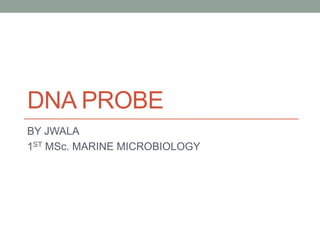
DNA probe
- 1. DNA PROBE BY JWALA 1ST MSc. MARINE MICROBIOLOGY
- 2. INTRODUCTION DEFINITION:- • In molecular biology, a probe is a fragment of DNA or RNA of variable length (usually 100-1000 bases long) which can be radioactively labelled.
- 3. TYPES OF PROBES • There are three types of nucleic acid probes:- 1. Oligonucleotide probes 2. DNA probes 3. RNA probes.
- 4. DNA PROBES • DNA probes are stretches of single stranded DNA used to detect the presence of complementary nucleic acid sequences (target sequences) by hybridisation. • These are longer than the oligonucleotide. • DNA probes are usually labelled, for example with radioisotopes, epitopes, biotin or fluorophores to enable their detection.
- 5. The chemically synthesized entity are:- • Fluorescent molecule • An attachment to a coloured bead • Quantum dots • Photo chromic compounds • Isotopic labelling • Non- isotopic labelling It allows us to visualize when a probe attaches to DNA, RNA or other target nucleic acids.
- 6. THE DNA MOLECULE • The basis of molecular biology is deoxyribonucleic acid or DNA. • The strands of DNA can be separated by heat (thermal denaturation) or by raising the pH or lowering the ionic strength of the DNA solution. • The DNA molecule is most stable in its native double stranded state. Thus when single stranded DNA is placed in solution, under appropriate temperature and salt conditions, the complementary strands will recombine to form a duplex molecule. • Complementary sequences of DNA can bind to RNA counterparts.
- 7. The hybridisation reaction consists of four components:- • The probe • The target (which is contained in the sample) • The reporter molecule and • The hybridisation method.
- 10. DESIGNING A PROBE • All organisms contain some unique sequences of DNA or RNA within their genome that distinguish them from all other organisms. • Hybridisation is a process whereby two single strands of nucleic acid come together to form a stable double- stranded molecule. As long as the sequences of bases along each stretch of nucleic acid are complementary, they will bind and stay together.
- 11. LABELLING OF DNA • Probes can be labelled at specific location within the oligonucleotides. • Some probes are of defined length. • Some probes are heterogenous population of labeled molecules. • Two ways for labelling 1. In vivo labelling 2. In vitro labelling
- 12. IN VIVO LABELLING • DNA can be directly labelled inside tissue culture cells by adding labelled deoxynucleotides in culture plate in vivo. • This method is restricted only to prepare labelled viral DNA from virus infected cells and to study RNA processing events.
- 13. IN VITRO LABELLING • It involves the process of labelling of purified DNA using DNA polymerase for incorporation of labelled nucleotides. • This process can be done through various methods:- 1. Nick-translation 2. Random printed labelling 3. PCR mediated labelling
- 14. DNA nick translation • It involves the insertion of random single strand breaks called “nicks” • The nicks in one strands of double stranded target DNA exposes 3’ and 5’ ends. • The nicks are introduced by endonuclease like pancreatic deoxyribonucleaseI (Dnase I)
- 15. RANDOM PRIME DNA LABELLING • This method is known as “oligo-labelling” • It is based upon hybridisation of a mixture of all possible hexanucleotides. • The template DNA is initially denatured. • The synthesis of new complementary DNA strands is primed by bound hexanucleotides. • Random hexanucleotides to bind at complementary sequences at which extension takes place through PCR. • It was catalyzed by klenow subunit of DNA polymerase I *The klenow fragment is a large protein fragment produced when DNA polymerase I from E.coli is ezymatically cleaved by the protease subtilisn.
- 16. PCR MEDIATED DNA LABELLING • The stranded PCR reaction can be modified to incorporate labelled nucleotides. • This method commonly uses 2 ways: 1. Standard PCR based DNA labelling The probe generation reaction is modified to incorporate one or more labelled nucleotide precursors at a concentration same as oligonucleotide concentrations.
- 17. 2. Primer mediated 5’ end labelling • Radio labelled probes can be generated for both strands using equal concentration of primers or heavily in favour of one strand of DNA using higher concentration of one primer. • It uses a 5’ end labelled primers.
- 18. PLASMIDS • To produce unique sequences, cloning vectors are used. • The commonly used vectors are Plasmids. • Plasmids are covalently closed circular pieces of DNA that replicate independently of the bacterial chromosome. They are not required for cell replication. • Size range:- 1000 bp to 40000 bp. • Cloning vectors are small plasmids often just 2-5 kilobases that contain a selectable marker such as ampicillin resistance and a stretch of DNA that can be cleaved by many different restriction endonucleases.
- 21. DIAGNOSTIC APPLICATIONS OF DNA PROBES • Advantages:- 1. Rapid detection and identification of infectious agents 2. The ability to screen selected specimens using batteries of probes 3. The detection of non viable or difficult to culture organisms.
- 22. • Disadvantages:- 1. Use of isotopic detection methods for optimum sensitivity 2. Limited diagnostic sensitivity of current assays 3. Slow turnaround time for some assay formats 4. Expense of current reagents 5. Limited availability of many probes 6. Lack of technical expertise in most diagnostic laboratories.
- 23. THANK YOU